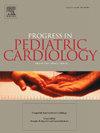Persistent pulmonary hypertension of the newborn
IF 0.6
Q4 PEDIATRICS
引用次数: 0
Abstract
Background
Persistent pulmonary hypertension in the newborn is associated with increased risk of cardiorespiratory failure, neurodevelopmental delay, and death.
Aim of review
The purpose of this article is to review normal and abnormal perinatal pulmonary vasculature adaptation and persistent pulmonary hypertension of the newborn, including etiology, pathophysiology, clinical manifestations, diagnostic methods, and treatment.
Key scientific concepts of review
Persistent pulmonary hypertension of the newborn is characterized by failure of the pulmonary vasculature in the newborn to adapt after birth, resulting in sustained high pulmonary vascular resistance, abnormal extrapulmonary right-to-left shunting of deoxygenated blood, and refractory hypoxemia. The etiology and pathophysiology of persistent pulmonary hypertension of the newborn may be classified into four broad categories, including maladaptation of a structurally normal cardiopulmonary system, underdevelopment of the lungs, maldevelopment of pulmonary vasculature in the absence of pulmonary parenchymal disease, and intravascular obstructions associated with increased blood viscosity from polycythemia. Infants with persistent pulmonary hypertension of the newborn may present with labile hypoxemia, with or without respiratory distress. Evaluation may include simultaneous pre- and post-ductal oxygen saturation measurements, chest radiography, echocardiography, and arterial blood gas analysis. The hyperoxia test may be useful when echocardiography is unavailable. The main goal in treating persistent pulmonary hypertension of the newborn is to reverse pulmonary vasoconstriction, optimize cardiac function, and improve systemic oxygen delivery. Treatment may include supportive measures such as sedation, correction of metabolic disturbances, management of polycythemia, oxygen therapy, and mechanical ventilation. Targeted therapy, depending on the underlying cause of disease, may include surfactant therapy, pulmonary vasodilator therapy, and optimization of hemodynamic status. Infants with refractory PPHN may require extracorporeal membrane oxygenation. Survivors of moderate to severe disease should be monitored for neurologic abnormalities, hearing loss, and cognitive delay.

求助全文
约1分钟内获得全文
求助全文
来源期刊

PROGRESS IN PEDIATRIC CARDIOLOGY
PEDIATRICS-
CiteScore
0.90
自引率
11.10%
发文量
69
审稿时长
75 days
期刊介绍:
Progress in Pediatric Cardiology is an international journal of review presenting information and experienced opinion of importance in the understanding and management of cardiovascular diseases in children. Each issue is prepared by one or more Guest Editors and reviews a single subject, allowing for comprehensive presentations of complex, multifaceted or rapidly changing topics of clinical and investigative interest.
 求助内容:
求助内容: 应助结果提醒方式:
应助结果提醒方式:


